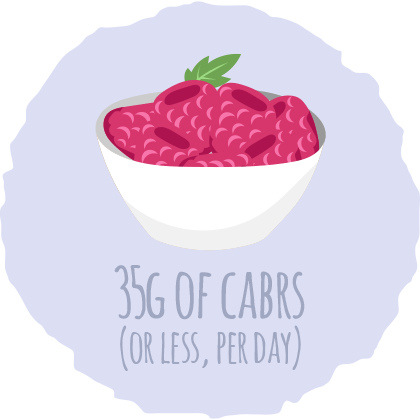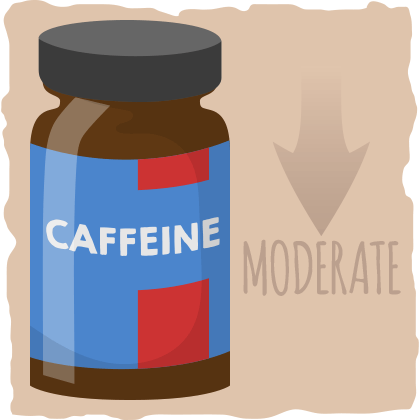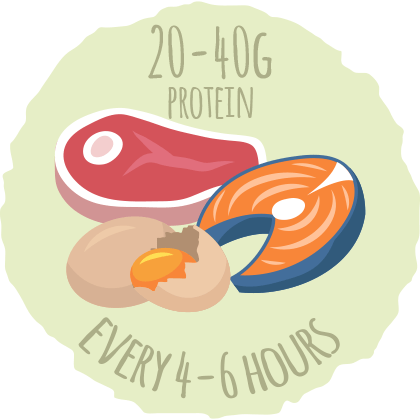Exercise more, and you’ll have better health. Follow the ketogenic diet, and you’ll lose weight rapidly and take your health to the next level. But what happens when you combine the two?
Although it’s reasonable to assume that combining exercise with keto would take your health and weight loss to the next level, the truth behind it is a bit more complicated than that. When we restrict carbs, we cause a plethora of changes throughout the body — some of which affect exercise performance.
How Keto Impacts Exercise Performance
By restricting carbs, we limit the ability of our muscle cells to access sugar — one of the fastest fuel sources that the body relies on. When our muscles don’t have enough sugar, their ability to function at high intensities (for any activity that lasts longer than 10 seconds) is impaired. This happens because — after around 10 seconds of near maximal to all-out effort — the muscles start to rely on glucose for energy by using a metabolic pathway called glycolysis instead of the phosaphen system (which depends on creatine phosphate and ATP, not glucose).
For this reason, any muscular activity that requires near maximal to all-out effort for 10 seconds to about 120 seconds can only be fueled by glucose. Fat and ketones cannot stand in for glucose in the glycolytic pathway at all. Only after around 2 minutes of exercise will your body start to shift to metabolic pathways that can burn ketones and fat.

To put it more simply, when we restrict carbs, we deprive our muscle cells of the sugar that it needs to fuel activities that require a high-intensity effort for 10 seconds to 2 minutes. This means that ketogenic diet can limit your performance during high-intensity activities like:
- Lifting weights for >5 rep sets using a weight that is heavy enough to take you to failure (or close to it).
- Sprinting or swimming for longer than 10 seconds (e.g., 100 meter sprint or 50 meter freestyle swim)
- Playing sports that have minimal rest breaks like soccer, rugby, and lacrosse
- High-intensity interval training or circuit training
This isn’t a comprehensive list of the activities that restricting carbohydrates will impact, but it gives you an idea of what types of exercise require your body to go into glycolysis and burn sugar.
Keep in mind, however, that the timing of each metabolic pathway depends on the person. Some people may be able to maintain their performance for high-intensity efforts that last 30 seconds without having to burn carbs, while others may burn out after 10 seconds of all-out effort.
Another caveat to be aware of when you are exercising on keto is that eating the right amount of fat and protein is doubly important. Carbs help provide a muscle preserving stimulus, and without having them in the diet, fat and protein must be consumed in the right quantities to maintain performance and gain muscle mass.
Eating The Right Quantity of Macronutrients While Exercising on Keto
When it comes to creating a diet plan for active individuals, many health professionals will set the protein intake first. Why does protein always seem to be the top priority?
Because protein performs many actions that carbs and fats just cannot emulate. For example, protein improves satiation, stimulates muscle protein synthesis (muscle building), and has a more significant thermic effect (more calorie burning) than any other macronutrient. On top of that, when we don’t eat enough protein we tend to lose muscle mass and consume more calories, which can lead to a rapid increase in body fat percentage.
To get all of these benefits, we must consume the right amount of protein — especially on the ketogenic diet.
Protein Intake Recommendations for Exercising on Keto

In the most recent International Society of Sports Nutrition position stand on diets and body composition, the researchers reported that a protein intake of 1.4-2 g per kilogram or 0.6-.9 grams per pound of lean body mass is ideal for athletes and others who exercise regularly.
If you are highly active and/or trying to lose weight, then you may benefit the most from eating around 2.2 grams of protein per kilogram of lean body mass (1 gram of protein per pound of lean body mass). This will help preserve muscle mass and promote fat loss.
Keto athletes will also benefit from higher protein intakes because their bodies will use the excess protein to provide their muscles with the glucose that they need by using a process called gluconeogenesis. However, if your goal is to get into deeper levels of ketosis, then it is best to divide your protein intake evenly between meals while eating a bit more protein after your workout to boost recovery (without impairing ketone production).
The best protein sources on the ketogenic diet are:
- Meat
- Eggs
- Fish
- High-fat dairy
- Low-carb protein powders
Here’s a quick recap of our protein recommendations:
If you are trying to gain or maintain muscle and improve exercise performance while on a ketogenic diet:
- Eat around 1 gram of protein per pound of lean body mass (2.2 g of protein per kilogram)
If you are trying to lose fat and maintain muscle:
- Eat around 1 gram of protein per pound of lean body mass (2.2 g of protein per kilogram)
- However, some may be able to gain muscle with protein intakes above ~1.3 grams per pound of lean body mass (3 grams per kilogram). The only downside to eating this much protein is that it may keep you from reaching deeper levels of ketosis.
To figure out how these numbers play into the rest of your ketogenic diet, use our keto calculator. It will provide you with the information you need to find out if you are eating enough protein and calories.
How Many Carbs Should You Eat?
In general, we recommend starting with 35 grams of carbs or less per day. Depending on your activity levels, you might be able to increase your carb limit without keeping you from ketosis.
If your exercise performance relies on high-intensity bouts of muscle activity that lasts longer than 10 seconds, then you may require some extra carbs to improve performance.
There are three methods by which you can do this:
1. Increase your daily carb limit by following the recommendations in this article.

2. Implement a Targeted Ketogenic Diet by consuming 25-50 grams of easily digestible carbs 30 minutes prior to exercise (best for exercise beginners).
3. Include carb 1-2 refeeding days every week by following a Cyclical Ketogenic Diet (best for athletes and people who exercise at high-intensities regularly)
Keep in mind that these suggestions do not apply to you if you mainly do aerobic-based endurance-type activities like cycling and jogging. These exercise methods are much less likely to be negatively impacted by the ketogenic diet. In fact, after you are keto-adapted, you may find that you can exercise at low to moderate intensities for longer periods of time without getting tired. This is because this type of exercise relies on fat and ketones for fuel, which are the exact fuels that your body prefers to use on the ketogenic diet.
We will learn more about training cardio on keto later in this article. For now, let’s top off our keto diet by getting some high-quality fats.
How Much Fat Should You Eat While Exercising on Keto?
On the ketogenic diet, fat consumption is almost as essential as protein intake. Eat too much, and you’ll gain weight — eat too little, and you’ll lose weight rapidly (while you starve throughout the whole process). To get the best results (and feel the best throughout the process), you must eat the right amount of fat according to your goals.
After you figure out your ideal protein intake, your fat consumption should be around 70% of your daily calories. From there you can adjust that number up or down depending on your goals.
Want to gain weight? Increase your daily fat intake until you are at a calorie surplus between 250-500 calories.
Want to lose weight? Decrease your calories from fat until you are in a 250-500 calorie deficit (or more if you are overweight or obese).
Key Takeaways — How Much Should You Eat While Exercising on Keto?

When we combine the recommendations for fat, protein, and carbs, what do we get? Well, it depends on your goals.
To optimize your diet for muscle gain and improved exercise performance:
- Eat a calorie surplus of 250-500 calories a day to increase your body weight by 0.5 to 1 pound a week.
- Most of the excess calories should come from fat, not protein or carbs.
- Maintain protein intake at around 1 gram per pound of lean body mass (~2.2 grams per kilogram
- of lean body mass).
- If carb restriction is impairing your performance, then consider implementing the targeted ketogenic diet or the cyclical ketogenic diet
To optimize your keto diet for fat loss while exercising:
- Calorie intake should be set at a level that results in steady weight loss. Weight loss of 0.5 to 1% per week is typically recommended to maximize muscle retention.
- Cut down on fat consumption to achieve a caloric deficit of 250-500 calories.
- Maintain protein intake at 1 gram per pound of lean body mass (~2.2 grams per kilogram) or more.
- If you are overweight or obese, you will benefit from faster weight loss (>1% of body weight lost per week) and a slightly higher calorie deficit.
For ketogenic dieters who do endurance exercise regularly:
- Follow the recommendations for fat, protein, and calories above.
- Start with a standard ketogenic diet (fewer than 35 grams of carbs per day), and assess how that affects your exercise performance after 1 to 2 weeks.
- If you notice no effect or an increase in endurance, then keep your carb limit as it is.
- If you are struggling to match your prior performance, then consider increasing your carb limit or supplementing with MCTs or exogenous ketones before your exercise bouts.
How To Exercise on The Keto Diet
Now that we have established the bigger picture of how keto impacts exercise performance and how to tailor the keto diet for different goals and activity levels, let’s take a look at the specifics — starting with athletes.
Keto For Athletes – From Ultra Endurance to Ultra High Intensity

There are many different types of sports that put varying demands on the body and its metabolic pathways. Each sport requires a slightly different dietary approach, but there are some general recommendations that most athletes can follow.
The most important thing to remember about competing and training for sports is that the body will need to burn sugar to some degree. Even in a sport like race walking, the body requires carbohydrates to push the limits of its capacity so that it can walk as fast as possible.
In fact, one study found that race walkers who were on a low carbohydrate group took an average of 23 seconds longer to complete a simulated race. Conversely, race walkers that were on a high-carb diet or a diet that is similar to a cyclical ketogenic diet experienced a significant improvement in performance.
These findings seem to contradict what we learned earlier about the different energy pathways. Shouldn’t race walkers have no problem with carbohydrate restriction since their performance relies on walking — a type of exercise that can easily be fueled by ketones and fat?
We must consider the fact that race walking isn’t the same as going for a leisurely evening stroll. Race walking requires athletes to push their bodies to the highest possible walking intensity, which will increase the demand on the glycolytic pathway. As a result, when the race walkers who were on the low-carb diet tried to push their bodies to the next level of intensity, they didn’t have the sugar available to make it happen, which lead to a decrease in performance.
With that being said, other scientific evidence suggests that keto-adapted endurance athletes may not experience the same decrease in performance. Once the athletes are keto-adapted, they tend to burn much more fat than high-carb athletes, which allows them to spare more glycogen for when they need to increase their intensity. In other words, the current data suggest that it is possible for keto-adapted ultra endurance athletes to have the same levels of performance as athletes who are on a high carb diet.
As the sport places a greater demand on the glycolytic pathway, however, the ketogenic diet becomes a less desirable dietary approach. Athletes who play sports like rugby, soccer, tennis, and lacrosse will most likely experience a decrease in performance — even if they are keto-adapted. This happens because these sports place a higher demand on the glycolytic pathway, which will require more glycogen than the body can store. For this reason, these athletes may benefit from consuming easily digestible carbs before a competition, following a cyclical ketogenic diet, or increasing their daily carb limit.
However, this doesn’t mean that the standard ketogenic diet isn’t ideal for any sport. Powerlifters, golfers, and some football players, for example, can follow the ketogenic diet without experiencing any performance decrements. This is because the performance of these athletes relies mainly on the phosphagen system. These athletes tend to use creatine phosphate and ATP to fuel their efforts because their sports usually require less than 10 seconds of high-intensity effort at a time.
When we take athletic performance out of the equation, we find that the ketogenic diet is one of the best diets for athletes that need to cut weight. By restricting carbs, boxers, wrestlers, and weightlifters can shed excess water weight rapidly so that they can make weight without having to lose muscle mass.
Also, many other athletes can use the ketogenic diet to lose fat during the offseason. This can help them improve their performance indirectly because they will carry much less weight with the same amount of muscle mass.
Key Takeaway for Keto Athletes
At this point, there is not enough data to recommend the ketogenic diet as a performance-enhancing diet for any sport. The athletes that may benefit most from a ketogenic diet are endurance athletes — but they may experience a dip in performance until they are keto-adapted.
Sports that require short bursts of maximal activity like powerlifting and golf will be unaffected by the ketogenic diet.
Perhaps that greatest benefit of the ketogenic diet for athletes is its ability to induce rapid weight loss in the first week and sustainable fat loss afterward. This can be beneficial for any athlete that must compete at a specific weight like boxers, wrestlers, and weightlifters or any athlete that will benefit from having a lower body fat percentage.
Doing Cardio on Keto
If you are not an athlete, then implementing the ketogenic diet will be a lot less complicated — especially if your primary form of exercise is cardio. The beauty of cardio workouts is that you don’t have to exercise at high-intensities that require your body to burn sugar and glycogen to get results. All you need to do is get your heart rate up and keep it up. As a result of this type of training, your health will improve in many ways that you can learn more about in this article.
Due to the low to moderate intensity of cardio, the ketogenic diet will not impair your cardio exercise performance. In fact, you may find that you can work out for much longer without getting tired when you are in ketosis.

The intensity that you need to maintain to get the most benefits is defined as “moderate intensity” by the CDC. For moderate-intensity physical activity, a person’s target heart rate should be 50 to 70% of his or her maximum heart rate.
To estimate your maximum heart rate, simply subtract your age from 220. For example, for a 50-year-old person, the estimated maximum age-related heart rate would be calculated as 220 – 50 years = 170 beats per minute (bpm). The 50% and 70% levels would be:
- 50% level: 170 x 0.50 = 85 bpm, and
- 70% level: 170 x 0.70 = 119 bpm
Thus, moderate-intensity physical activity for a 50-year-old person will require that the heart rate remains between 85 and 119 bpm during physical activity.
As you are adapting to the ketogenic diet, aim for the lower end of the range (50% level). After a couple of weeks on the diet, you will be able to maintain a higher heart rate for longer without needing to burn too many carbs.
If you are just starting to do cardio exercise, then aim to maintain 50% of your max heart rate for 10-15 minutes. Increase the duration of exercise by 5 or so minutes each week until you can do between 30 and 45 min with your average heart rate being around 50% of your calculated max. After that, start increasing the intensity each week until you can exercise at around 70% of your max heart rate.
Here are some examples of great ways to get your cardio in:
- cycling
- running
- circuit training
- interval training classes
- recreational sports
- aerobic training classes
- swimming
Keep in mind that your strength and power in some of these activities may decrease as a result of carbohydrate restriction. However, if your goal is to get a good cardiovascular workout, then there is no need to push yourself to the point where maximizing your strength and power actually matters.
Does this mean that we can’t increase strength and power while following the ketogenic diet? No, not at all. All it takes is some mindful exercise programming and relatively heavy weights.
Weight Lifting On The Ketogenic Diet
Strength, power, and muscle mass can all be increased while you are on the ketogenic diet. What’s even better is that you can improve them all at the same time with the same workout program.
Remember how earlier we discussed that the body doesn’t require glucose for activities that last fewer than 10 seconds long? This is because we rely on stored ATP and creatine phosphate to fuel these quick and intense muscular actions. As a result, carbohydrate restriction will not impair these brief, max effort muscular contractions.
What does this mean for weightlifters? That it is possible to improve strength, power, and muscle mass on keto by doing sets that last no longer than 10 seconds.

In other words, a weightlifting program that prescribes five or more sets of five or fewer reps per exercise is an ideal approach for keto weightlifters who are aiming to increase strength and power.
Recent research suggests that lower rep sets can be used to maximize hypertrophy (muscle gain) as well. That’s right — your muscles don’t need you to do 8-12 reps in order to grow. What your muscle needs to grow is the appropriate volume (which depends on the individual), and for that volume to increase every week (with some lower volume weeks dispersed throughout the program to prevent overtraining). For a more precise breakdown of how to design a muscle building program while you are on keto, read through our comprehensive guide to bodybuilding on the ketogenic diet.
If you would rather stick to the old-fashioned bodybuilding programs and do higher rep ranges with lighter weights, then try supplementing your ketogenic diet with carbs. Exercise beginners can improve performance by following the targeted ketogenic diet, while more experienced weightlifters will find much more benefit from the cyclical ketogenic diet.
However, don’t take these recommendations to mean that you can’t gain muscle without carbs. Carbs are necessary for fueling certain high-intensity activities, but this doesn’t mean that they are absolutely necessary for bodybuilding.
Can You Build Muscle Without Carbs?
Carbs have an anti-catabolic effect on the body (they prevent muscle breakdown) — but they are not needed to build muscle. As long as you follow the nutrition recommendations that you find throughout this article and the other suggestions in our article on bodybuilding, you will gain muscle.
In general, as long as you are eating enough protein and calories and working out at high-intensities with enough volume, you will be able to build plenty of muscle. Plus, you can take your results one step further by experimenting with some keto-friendly workout supplements.
Supplements for Improving Exercise Performance on the Ketogenic Diet
There are many different no-carb supplements that you can use to boost exercise performance while you are on keto. Here is a list of some of the most effective keto-friendly workout supplements that we know of:
Creatine
Creatine is one of the most well-studied supplements and is safe and effective in enhancing your body’s phosphagen system. This makes creatine the ideal supplement for explosive athletes and weightlifters.
Taking 5 grams per day of a cheap monohydrate powder is the perfect supplementation strategy for anyone looking to increase muscle mass, strength, and power.
Recommendations: Take 5 grams of creatine monohydrate powder per day.

Medium Chain Triglycerides (MCTs)
MCTs are a type of saturated fat that goes straight to the liver after digestion.
In the liver, these fats tend to be converted into ketones and sent to the cells in your body that need them for energy. For this reason, MCTs are perfect for cardio training and endurance athletes.
Recommendations: Supplement with 1-2 tablespoons of MCT oil or MCT powder before your endurance-type workouts for an extra energy boost.

Exogenous Ketones
Exogenous ketones like ketone salts and ketone esters can help provide the body with an instant source of energy. However, these supplements will lower your liver’s ketone production, so it is best to consume these with MCTs to boost ketone production within your body as well.
Just like MCTs, exogenous ketone supplementation is best for cardio training and endurance athletes. Just make sure that you are staying hydrated when you consume these supplements because they have a mild diuretic effect on the body.
Recommendations: Try supplementing with a BHB ketone salt or ketone ester for an energy boost during workouts. Take it with MCTs for even better results.

Caffeine
It is no surprise that caffeine has been found to improve exercise performance given its stimulatory effects.
However, you may not get the same boost after taking caffeine consistently because of how quickly the body adapts to habitual caffeine intake. Plus, caffeine increases cortisol levels, which tends to decrease ketone production.
For these reasons, I’d suggest limiting your caffeine intake and experimenting with other supplements on this list.

Taurine
Taurine is an organic acid that is known to improve exercise performance. In fact, it has been found to improve exercise performance more than caffeine.
In a recent study, researchers compared the effects that caffeine, caffeine+taurine, and taurine had on power and fatigue during an all-out cycling sprint. Taurine supplementation alone decreased fatigue and increased power more than caffeine and caffeine+taurine.
These findings have significant implications for keto athletes and bodybuilders because this study tested the energy system that is most compromised by carb restriction.

Recommendations: The study mentioned above gave their participants 50 mg of taurine per kilogram of body weight. Use this metric to find your personalized dose and slowly decrease it to see if you can get the same effects from taking less taurine.
Beta-alanine
This compound is commonly found in pre-workout supplements that give you a tingly sensation throughout your body.
Many people report being able to perform one or two more reps in the gym when training in sets of 8–15 repetitions after taking beta-alanine.
This suggests that this supplement is ideal for keto dieters that rely on the glycolytic pathway (glucose) throughout their training. Bodybuilders and high-intensity athletes will benefit most from supplementing with beta-alanine.

Recommendations: With beta-alanine, timing doesn’t matter. Take 2–5 g of beta-alanine with 5 g of creatine every day for best results. If the tingly sensation that beta-alanine gives you is too uncomfortable, then take 1 gram of beta-alanine 2-5 times throughout the day.
L-Citrulline
L-Citrulline is commonly used as a sports performance and cardiovascular health supplement. Studies have found the L-citrulline supplementation helps reduce fatigue and improve endurance for both aerobic and anaerobic prolonged exercise.
This makes it the ideal supplement for almost every athlete, except for the athletes who rely solely on the phosphagen system like golfers and powerlifters.
Recommendations: To enhance exercise endurance, take 6,000 – 8,000 mg of citrulline malate about an hour before training.

Protein Powder
Although we recommend getting most of your protein from whole food sources, protein powder is a great supplement that can help you meet your protein needs more easily.
Stick with complete protein powders like whey, casein, collagen, or a mix of different plant protein powders. Don’t waste your time with BCAA and EAA supplements as you will get much more benefit from taking a complete protein powder.
Recommendations: Add 20-40 grams of a complete protein powder to your smoothies or take it after your workouts to stimulate muscle protein synthesis without taking you out of ketosis.

Alpha GPC
Choline is an essential component of your nervous system. Every time a muscle moves within the body, choline is needed to activate the neurotransmitter acetylcholine, which sends chemical signals to muscles and makes them mobile. One of the best ways to get enough choline is by taking alpha GPC.
Studies have found that 600 mg of alpha GPC can enhance power output and growth hormone secretion, which suggests that this form of choline is likely a great supplement for athletes and weightlifters to add to their diet.
Recommendations: Take 600 mg of alpha GPC before your workouts to increase strength and power.

Fish Oil
Fish oil, specifically the omegas 3s fatty acids known as DHA and EPA, help boost recovery and stimulate muscle protein synthesis.
The American Heart Association recommends consuming 1g of EPA+DHA daily. This recommendation can be met by taking a fish oil supplement or eating a 3-ounce serving of sardines or salmon per day.
Furthermore, if the goal of supplementation is to reduce soreness, then a 6g dose, spread over the course of a day, will help.
Recommendations: Supplement with at least 1 gram of DHA+EPA every day. Use Nordic Naturals Ultimate Omega and eat wild-caught (not farm-raised) salmon and sardines for the best results.

Keto Pre Workout
Many pre-workout supplements are keto-friendy, some of which are marketed directly to ketogenic dieters. These pre-workout supplements will typically contain most of the compounds we talked about in the previous section.
The only problem with purchasing these supplements — as well as the supplements made specifically for keto dieters — is that they may not have the effective dosages of the ingredients listed. So, even though some of these pre-workouts supplements contain ingredients that have been proven to boost performance, this doesn’t mean that they are found in high enough doses to evoke any benefits.
For this reason, I recommend buying each individual ingredient and putting the ones you want to use in a pre-workout keto-friendly smoothie. Taurine, l-citrulline, creatine, alpha GPC, and beta-alanine can all be added into a smoothie along with some flavored protein powder (20-40g of protein), MCTs, and/or exogenous ketones to make the perfect pre-workout drink. Keep in mind that you don’t need to add every supplement to your smoothie. Refer to the descriptions above to see what supplement or supplements will provide the benefits you want for the exercise you are doing.
Here are some example of keto-smoothies you can experiment with:
-
Blueberry Banana Bread Smoothie
Before you say it, I know what you're thinking: "But Craig, bananas are definitely not allowed on a ketogenic diet!" Don't worry g...
McKeto Strawberry Milkshake
Growing up as a kid, I had my fair share of fast food takeout. Some of them I still miss to this day and try to recreate (a lot of...
Cucumber Spinach Smoothie
I've had a lot of people e-mail me and ask me about juicing (which is a no-no). When they make the switch to a ketogenic diet, the...
Blackberry Chocolate Shake
You know those chocolate covered berries you find in those specialty candy stores, or the ones that they serve up to you when you ...
Keto Tropical Smoothie
Come along and savor the last few days of summer that are left with me! Sit back, relax, and pour yourself a fruity and refreshing...
Side Note: If you are following a targeted ketogenic diet or have a higher than average carb limit, then consider adding beets to your pre-workout drink. Studies have shown that beets help reduce the ATP requirements of exercise, which indirectly increases performance. Blend 200 grams of beetroot into your pre-workout drink for best results. Make sure you include the carb content of the beets into you carb tracking for the day (200 grams of beetroot contains 19 grams of carbs and 13.5 grams of net carbs).
Recommendations: Whether you buy a pre-workout supplement or make it yourself, make sure it contains enough of the active ingredients to have a positive effect. Also, watch out for added sugars, as they can be found in many pre-workout supplements
Keto Post Workout
Studies have found that there is no need to slam protein shakes after your workout to fit your protein consumption into a small “anabolic window.” Instead, there seems to be a 4-6 hour anabolic window that occurs after we eat more than 20 grams of complete protein. During this window of time, muscle protein synthesis is increased, which can lead to muscle growth.
For example, let’s say you had 40 grams of protein in your pre-workout smoothie. The anabolic effects of that protein may be elevated for up to 6 hours after ingestion. For this reason, it is best to focus on eating a minimum of 20-40 grams of protein every 4-6 hours to trigger muscle protein synthesis throughout the day. To meet your daily protein needs, you may need to consume a bit more protein per meal.

If the amount of protein you have to eat per meal is keeping you from meeting your ketosis goals, then try consuming more protein after your workout than at any other meal. After your workouts, your cells will require much less insulin to create the same anabolic effect. With lower insulin levels, your liver will be less likely to decrease the number of ketones it produces.
Recommendations: Your top priority is to meet your daily protein goals. To optimize the muscle building effect of the protein without lowering your ketone levels, eat 20-40 grams of protein or more with every meal (every 4-6 hours) and have your biggest protein meal after your workouts. To further boost recovery and muscle growth, take fish oil or eat fatty fish with your post-workout meal.
Putting it All Together — Exercise and The Ketogenic Diet in Perfect Harmony
Keto is not the ideal diet for high-intensity activities, but it is the ideal diet for weight loss, reversing many chronic diseases, and improving our health in many ways.
To combine exercise and keto together, we must make changes to our diet and workout program to accommodate the effect that carbohydrate restriction has on physical performance. Keto athletes and competitors, in particular, need to make sure they are eating the right amount of macronutrients, following the proper keto diet variation and taking the right supplements to improve their performance while simultaneously experiencing the health benefits of the ketogenic diet.
On the other hand, if you are just trying to add exercise and keto into your lifestyle to improve your health, then you have more room to experiment with what is best for you. In general, I recommend lifting weights and doing some form of cardio training every week. Ideally, this would mean doing cardio exercise 2-3 times per week and lifting weights 2-3 times per week — never doing them both on the same day (for best results).
Although exercising in this way is not the key to losing weight, it will help you gain muscle and improve your cardiovascular health will improve your health in many ways — from reducing insulin resistance, inflammation, stress, pain, and chronic disease risk to improving memory, mood, sleep, and cognitive function.
By following the recommendations in this article and our beginner’s guide to the keto diet, you will be able to use exercise and carbohydrate restriction to improve your health in every way.
Sources:
- Long-term health benefits of physical activity – a systematic review of longitudinal studies — BMC Public Health
- Health benefits of physical activity: the evidence — NCBI
- Regular exercise changes the brain to improve memory, thinking skills — Harvard Medical School
- Metabolic characteristics of keto-adapted ultra-endurance runners. — NCBI
- Balance of carbohydrate and lipid utilization during exercise: the “crossover” concept. — NCBI
- Rethinking fat as a fuel for endurance exercise. — NCBI
- Capacity for moderate exercise in obese subjects after adaptation to a hypocaloric, ketogenic diet. — NCBI
- The human metabolic response to chronic ketosis without caloric restriction: preservation of submaximal exercise capability with reduced carbohydrate oxidation. — NCBI
- Fueling strategies to optimize performance: training high or training low? — NCBI
- Alpha-GPC — Examine
- Very-low-carbohydrate diets and preservation of muscle mass — NCBI
- Ketogenic diet does not affect strength performance in elite artistic gymnasts — BioMed Central
- Resistance training in overweight women on a ketogenic diet conserved lean body mass while reducing body fat — BioMed Central
- Relatively high-protein or ‘low-carb’ energy-restricted diets for body weight loss and body weight maintenance? — NCBI
- Effects of dietary carbohydrate restriction with high protein intake on protein metabolism and the somatotropic axis. — NCBI
- The Effects of Ketogenic Dieting on Body Composition, Strength, Power, and Hormonal Profiles in Resistance Training Males — Ovid Insights
- Ketogenic diet benefits body composition and well-being but not performance in a pilot case study of New Zealand endurance athletes — Springer Link
- Can Fat Fuel The Athlete — Chris Masterjohn PhD
- Effects of variation in protein and carbohydrate intake on body mass and composition during energy restriction: a meta-regression — The American Journal of Clinical Nutrition
- Dietary protein – its role in satiety, energetics, weight loss and health — British Journal of Nutrition
- International society of sports nutrition position stand: diets and body composition — Journal of the International Society of Sports Nutrition
- The Three Metabolic Energy Systems — IDEA Fit
- The Science of Carbohydrate Loading — Marathon Training
- Effects of different volume-equated resistance training loading strategies on muscular adaptations in well-trained men. — NCBI
- A Systematic Review of Dietary Protein during Caloric Restriction in Resistance Trained Lean Athletes: A Case for Higher Intakes — Human Kinetics Journals
- Fasting enhances growth hormone secretion and amplifies the complex rhythms of growth hormone secretion in man. — NCBI
- Nutrient timing revisited: is there a post-exercise anabolic window? — Journal of the International Society of Sports Nutrition
- Low carbohydrate, high fat diet impairs exercise economy and negates the performance benefit from intensified training in elite race walkers — The Journal of Physiology
- The human metabolic response to chronic ketosis without caloric restriction: preservation of submaximal exercise capability with reduced carbohydrate oxidation. — NCBI
- Why you won’t lose weight with exercise alone — Science Daily
- Can beets help you run faster? — Precision Nutrition